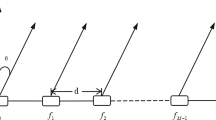Abstract
A novel approach for dual-function radar-communication (DFRC), by making use of frequency diversity in waveforms, is proposed in this paper. This is an approach to make use of an available band of spectrum (2.38–2.42 GHz) for both radar and communication. Unlike the previous approaches, the system can process both radar and communication signals simultaneously. Digitization of receive signals at the element level gives a way to deliver maximum flexibility. The use of neural network is to minimize the BER and for optimizing beam formation. MUSIC algorithm is applied to phased array to precisely estimate the arrival directions of signals.
Access this chapter
Tax calculation will be finalised at checkout
Purchases are for personal use only
Similar content being viewed by others
References
R. Cager, D. LaFlame, L. Parode, Orbiter Ku-band integrated radar and communications subsystem. IEEE Trans. Commun. 26, 1604–1619 (1978)
A. Hassanien, B. Himed, B.D. Rigling, A dual-function MIMO radar-communications system using frequency-hopping waveforms, in Radar Conference (RadarConf) (IEEE, New York, 2017), pp. 1721–1725
E. BouDaher, A. Hassanien, E. Aboutanios, M.G. Amin, Towards a dual-function MIMO radar-communication system, in Radar Conference (RadarConf) (IEEE, New York, 2016), pp. 1–6
A. Hassanien, M.G. Amin, Y.D. Zhang, F. Ahmad, Phase-modulation based dual-function radar-communications. IET Radar Sonar Navig. 10(8), 1411–1421 (2016)
A. Hassanien, M.G. Amin, Y.D. Zhang, F. Ahmad, Signaling strategies for dual-function radar communications: an overview. IEEE Aerosp. Electron. Syst. Mag. 10, 36–45 (2016)
J. Euziere, R. Guinvarc’h, M. Lesturgie, B. Uguen, R. Gillard, Dual function radar communication time-modulated array, in 2014 International on Radar Conference (Radar) pp. 1–4 (2014)
L. Xie, X. Yin, L. Yang, C. Lu, H. Zhao, Multifunctional communication transceiver with distance measurement capability, in 2014 Asia-Pacific Microwave Conference (APMC) (IEEE, New York, 2014), pp. 405–407
A. Hassanien, M.G. Amin, Y.D. Zhang, F. Ahmad, Dual-Function radar-communications: information embedding using Sidelobe control and waveform diversity. IEEE Trans. Signal Process. 64(8), 2168–2181 (2016)
B. Sridhar, I.A. Sheriff, K.N. Kutty, S.S. Kumar, Comparison of cascaded LMS-RLS, LMS and RLS adaptive filters in non-stationary environments, in Novel Algorithms and Techniques in Telecommunications and Networking (Springer, Dordrecht, 2010), pp. 495–499
L. Merad, F.T. Bendimerad, S.M. Meriah, S.A. Djennas, Neural networks for synthesis and optimization of antenna arrays. Radioeng.-Prague 16(1), 23 (2007)
A.L. Tatuzov, Neural network methods for radar processing, in Proceedings of the 9th International Conference on Neural Information Processing, 2002. ICONIP’02, vol. 4 (IEEE, New York, 2002), pp. 1718–1722
R.A. Monzingo, T.W. Miller, Introduction to Adaptive Arrays (Scitech publishing, 1980)
J.S. Herd, M.D. Conway, The evolution to modern phased array architectures. Proc. IEEE 104(3), 519–529 (2016)
A. Hassanien, M.G. Amin, Y.D. Zhang, F. Ahmad, Signaling strategies for dual-function radar communications: an overview. IEEE Aerosp. Electron. Syst. Mag. 36–45 (2016)
S.H. Talisa, K.W. O’Haver, T.M. Comberiate, M.D. Sharp, O.F. Somerlock, Benefits of digital phased array radars. Proc. IEEE 104(3), 530–543 (2016)
L. Huang, Y. Zhang, Q. Li, J. Song, Phased array radar-based channel modeling and sparse channel estimation for an integrated radar and communication system. IEEE Access 5, 15468–15477 (2017)
G. Prabha, G.S. Sundaram, Estimation of DOA using a cumulant based quadricovariance matrix, in 10th European Conference on Antennas and Propagation (EuCAP) (IEEE, New York, 2016), pp. 1–5
G.C. Lin, Y.A. Li, B.L. Jin, Research on uniform array beamforming based on support vector regression. J. Mar. Sci. Appl. 9(4), 439–444 (2010)
H.H. Chen, S.C. Chan, Adaptive beamforming and DOA estimation using uniform concentric spherical arrays with frequency invariant characteristics. J. VLSI Signal Process. Syst. Signal Image Video Technol. 46(1), 15–34 (2007)
Author information
Authors and Affiliations
Corresponding author
Editor information
Editors and Affiliations
Rights and permissions
Copyright information
© 2019 Springer Nature Singapore Pte Ltd.
About this paper
Cite this paper
Anjali, K.S., Prabha, G. (2019). Dual-Function Radar-Communication Using Neural Network. In: Wang, J., Reddy, G., Prasad, V., Reddy, V. (eds) Soft Computing and Signal Processing . Advances in Intelligent Systems and Computing, vol 900. Springer, Singapore. https://doi.org/10.1007/978-981-13-3600-3_50
Download citation
DOI: https://doi.org/10.1007/978-981-13-3600-3_50
Published:
Publisher Name: Springer, Singapore
Print ISBN: 978-981-13-3599-0
Online ISBN: 978-981-13-3600-3
eBook Packages: Intelligent Technologies and RoboticsIntelligent Technologies and Robotics (R0)




